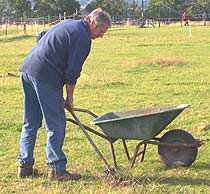
Redworms in Horses - Symptoms, Treatment, Control

Horses become infected with
redworms while grazing
Redworms - Strongulus - are tiny worms which are thin as a thread of cotton and up to 2.5 centimeters long.
Redworms consist of about 50 different species - but only 10-12 are species are commonly found in horses.
If left uncontrolled they can kill a horse.
They live in the intestines of a horse or pony where the redworm lays eggs that pass out with the horse's droppings.
Redworms can be seen in the droppings after worming.
The redworm eggs hatch when condtions are warm and moist.
REDWORM LARVAE
The infective larvae then crawl up blades of grass and get eaten by the horse.
Once inside a horse redworms burrow into the gut lining, and although some worms complete their development there, others travel further.
Some species of redworm invade the horse's liver after an eight month journey.
The larvae of one species - Strongulus Vulgaris - get into the arteries supplying the intestines and travel against the blood flow until they reach the main blood vessel supplying the intestines.
The redworms develop there for several months before returning back down the blood vessel and into the intestine.
This leads to damage to the artery walls and development of blood clots where the worms settle.
If these clots, known as thrombi, break away they may block blood vessels and stop the blood supply to part of the intestine.
SYMPTOMS AND SIGNS OF REDWORM DAMAGE IN HORSES
The symptoms of redworm damage may include
- Loss of condition
- Severe weight loss
- Anaemia
- Distended stomach
- Staring or dull coat
- Diarrhoea
- Colic
- Fluid swellings in the legs, round the sheath or on the stomach.
As redworms attach themselves to the horse's gut and are absorbed into it they reduce the ability of the intestine to absorb essential nutrients.
This can lead to general poor condition in the horse as a result of him being unable to properly utilise a balanced diet.
HOW TO CONTROL REDWORM
 The
best methods of controlling redworm include a good worming program, regularly
removing droppings from the horse's paddock and rotating grazing.
The
best methods of controlling redworm include a good worming program, regularly
removing droppings from the horse's paddock and rotating grazing.
The recommended worming routine for redworm is to give a 5-day course of fenbendazoleD (such as Panacur Equine Guard) or a single dose of a moxidectin based wormer in February and November.
An alternative method of Redworm control is to have regular Worm Counts and only worm as necessary. This reduces the chance of redworm becoming resistant to wormers